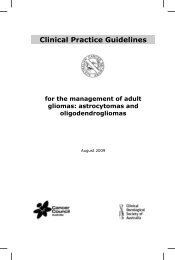Clinical Practice Guidelines for the management of locally advanced ...
Clinical Practice Guidelines for the management of locally advanced ...
Clinical Practice Guidelines for the management of locally advanced ...
You also want an ePaper? Increase the reach of your titles
YUMPU automatically turns print PDFs into web optimized ePapers that Google loves.
A2.1.5 Critical appraisal and summary<br />
For each clinical question, <strong>the</strong> included studies and <strong>the</strong>ir results were summarised in a template<br />
(Template 1 in <strong>the</strong> Handbook 9 ). Each study was submitted to fur<strong>the</strong>r critical appraisal. The level <strong>of</strong> <strong>the</strong><br />
evidence, <strong>the</strong> quality <strong>of</strong> evidence as determined above, <strong>the</strong> size <strong>of</strong> effect and relevance <strong>of</strong> <strong>the</strong> evidence<br />
<strong>of</strong> each included study was documented.<br />
Details <strong>of</strong> <strong>the</strong> templates, rating systems, and criteria <strong>for</strong> <strong>the</strong> critical appraisal process are available on<br />
<strong>the</strong> Australian Cancer Network website (). Levels <strong>of</strong> evidence are outlined<br />
below.<br />
Table 1 Designations <strong>of</strong> levels <strong>of</strong> evidence according to type <strong>of</strong> research question<br />
(NHMRC, 2005)<br />
Level Intervention<br />
I A systematic review <strong>of</strong> level II studies<br />
II A randomised controlled trial<br />
III-1 A pseudo-randomised controlled trial (ie alternate allocation or some o<strong>the</strong>r method)<br />
III-2 A comparative study with concurrent controls:<br />
non-randomised, experimental trial<br />
cohort study<br />
case-control study<br />
interrupted time series with a control group<br />
III-3 A comparative study without concurrent controls:<br />
historical control study<br />
two or more single-arm studies<br />
interrupted time series without a parallel control group<br />
IV Case series with ei<strong>the</strong>r post-test or pre-test/post-test outcomes<br />
Source: Development <strong>of</strong> clinical practice guidelines <strong>for</strong> <strong>the</strong> <strong>management</strong> <strong>of</strong> cutaneous melanoma and melanoma in special<br />
sites: Handbook <strong>for</strong> chapter leaders and expert working groups 9 , p18<br />
A2.1.6 Assess <strong>the</strong> body <strong>of</strong> evidence and <strong>for</strong>mulate recommendations<br />
The body <strong>of</strong> literature was assessed by each expert sub-committee in regard to <strong>the</strong> volume <strong>of</strong> <strong>the</strong><br />
evidence, its consistency, clinical impact, generalisability and applicability. These aspects were<br />
graded and documented in a second template (Template 2 in <strong>the</strong> Handbook 9 ).<br />
Following grading <strong>of</strong> <strong>the</strong> body <strong>of</strong> evidence, expert sub-committees were asked to <strong>for</strong>mulate a<br />
recommendation that related to <strong>the</strong> summarised body <strong>of</strong> evidence. This recommendation also had to<br />
be graded as follows:<br />
<strong>Clinical</strong> practice guidelines <strong>for</strong> <strong>the</strong> <strong>management</strong> <strong>of</strong> <strong>locally</strong> <strong>advanced</strong> and metastatic prostate cancer<br />
120



